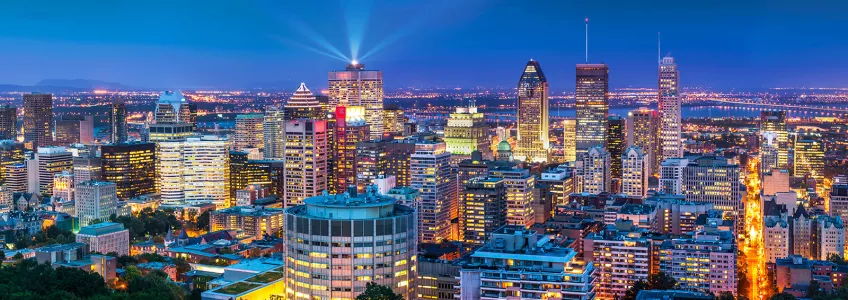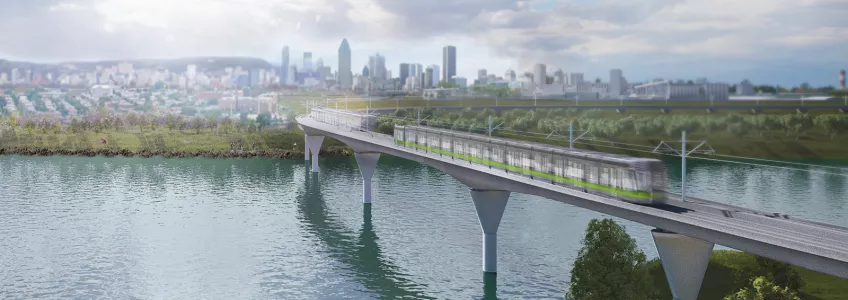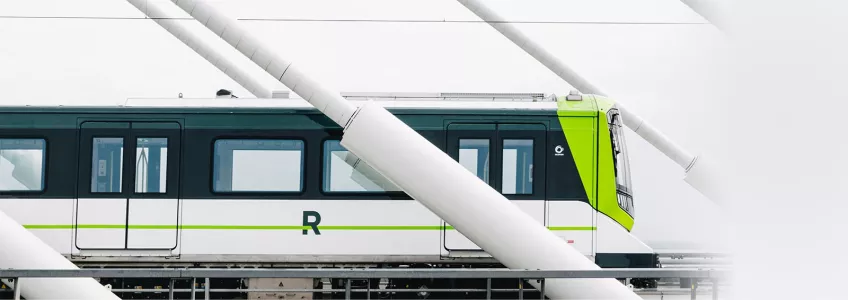Infrastructure: rooted in our daily lives
Check against delivery.
This morning, you may have taken your car, driven on the highway, or used public transit.
Perhaps some have recently taken the plane?
Right now, every one of you has a glass of water – thanks to the well-maintained water supply systems.
This month, some will be lucky enough to attend a concert at the Maison symphonique.
And, as soon as it’s warm enough outside, you will probably have a BBQ – maybe one fueled by natural gas?
We use infrastructure on a daily basis. It’s all around us.
It’s airports, ports, public transit and roads. Electricity transmission and drinking water supply systems. It’s research centres and even concert halls. It’s also wind and solar energy.
Infrastructure is what allows people to function. Day after day.
What’s more, infrastructure has a significant impact on our economy.
For instance: according to the IMF’s calculations, $1 invested in new infrastructure leads to $1.40 of new economic activity. And if $100 billion is spent on new infrastructure, 800,000 jobs can be created.
In other words, investing in infrastructure stimulates both economic growth and productivity.
However, around the world, infrastructure needs are staggering. The numbers are so astronomically high that they can seem unrealistic.
According to the McKinsey Global Institute, $2.5 trillion are being spent annually on transportation, water, energy and telecom infrastructure.
Infrastructure that allows us to travel, heat our homes, research current events on the web and transport goods.
Does $2.5 trillion seem like a lot to you? Yes, but it still falls short.
We actually need to invest $3.3 trillion annually until 2030 just to support growth forecasts.
The difference between the two figures is the deficit in infrastructure financing — known as the infrastructure gap.
In the United States, the American Society of Civil Engineers expects that another $2 trillion will be necessary to satisfy infrastructure needs there by 2025.
In Canada, where estimates are harder to assess, the gap appears to be somewhere between $150 billion and $1 trillion.
And then there’s emerging markets, which represent 60% of the demand for the next 15 years.
Investing in infrastructure stimulates both economic growth and productivity.
Governments are attempting to find solutions to the problem.
Our world today is marked by uncertainties. Protectionism. Geopolitical risks. The rise of populism. But economically and politically, there seems to be at least one consensus: investing in infrastructure is imperative.
During the last U.S. electoral campaign, Donald Trump and Hilary Clinton proposed investments, most notably in roads, bridges and airports. And they emphasized the number of jobs that would be created as a result.
Donald Trump promised a US$1-trillion infrastructure development plan, notably through public-private partnerships.
Hillary Clinton, for her part, hoped to implement an infrastructure development plan estimated at US$275 billion over five years.
Their figures differed but the goal was the same: invest in infrastructure to drive the economy.
But investing in infrastructure is no easy task. Why? Because costs are short-term, and the benefits, long-term.
In attempting to close the gap between existing investments and those that are necessary, attention has turned to investors like la Caisse.
The good news: we have a big appetite for infrastructure.
That’s because the assets are stable and predictable. As I said earlier, these assets are used every day. They’re “real,” tangible, making them less sensitive to market fluctuations. In short, infrastructure is more resilient in the event of an economic crisis.
Since interest rates have been extremely low over the past few years, infrastructure has become an alternative source of returns with a low risk of capital loss. That’s a good option for our clients.
And financial institutions, such as pension funds and many sovereign wealth funds – long-term investors – have the capital needed to invest in infrastructure. We’re talking about an enormous pool of capital, considering these institutions manage approximately $45 trillion worldwide.
However, there is a downside: the more investors want their slice of the pie, the more competitive the market becomes, seeing as the number of concrete, attractive opportunities remains limited.
How does la Caisse approach all this?
1) By making direct investments in infrastructure… since 1999:
The first asset we invested in was Highway 407 in Ontario.
Over the years, we have added Heathrow Airport, wind farms in the U.K. and the U.S., the Canada Line in Vancouver, a port and seven social infrastructure projects in Australia – including the Victorian Comprehensive Cancer Center, a state-of-the-art cancer research centre.
In 2015, we acquired a stake in Eurostar, a high-speed passenger train, which connects London to Paris and Brussels via the Channel Tunnel. One of the best-known transportation systems in all of Europe.
These are just examples, but they illustrate our infrastructure portfolio growth.
A portfolio that has grown from $3 billion in 2010 to close to $15 billion in December 2016. It’s a portfolio focused on diversification – both from sectoral and geographic perspectives.
In attempting to close the gap between existing investments and those that are necessary, attention has turned to investors like la Caisse.
2) To build this portfolio, we have implemented a partnership approach.
Our business model focuses on strategic partnerships with the largest infrastructure operators in the world.
One example is our investment platform announced in the fall of 2016 with our partner DP World, one of the largest port operators in the world. Together we created a $5-billion investment vehicle, which included, from the start, container terminals located in Vancouver and Prince Rupert.
Not only does DP World share our long-term vision, but it gives us unique access to strategic transactions throughout the world.
This partnership is an example that perfectly illustrates our strategy:
- To invest in real assets – transportation of goods is central to global economic dynamics
- To identify partners who have sophisticated knowledge of a sector – be it rail transportation, airports, wind energy or ports
- And to work with partners who have extensive market knowledge
3) These partnerships have given us the opportunity to complete key transactions in growth markets over the past few years.
In infrastructure, these transactions are currently concentrated in Mexico and India.
In Mexico, we have developed an investment platform with local institutional investors. We bring to the table our infrastructure expertise, and, in turn, our partners share their networks and in-depth market knowledge.
As an example for India, we have a significant interest in Azure Power, a solar power leader.
La Caisse is interested in growth markets. All asset classes combined. But considering that close to $2 trillion in infrastructure investment will be required by 2030 in these markets, we know opportunities will arise.
Urbanization will also play a major role in these needs: by 2050, more than 6 billion people will live in cities, compared to about 4 billion, today.
4) Beyond partnerships, we need to build on the strength of our people.
And this is true for every one of us, regardless of our sector of activity.
Over recent years, my colleagues’ complementary expertise has been more valuable than ever.
Our sector is so diversified. Public transit is completely different from a water supply system. We need people with varied profiles who understand the operations, the specific features and ins and outs of each of industry.
Our team rely on engineers, financiers, accountants. People who have worked here, as well as in Asia-Pacific, Australia and Mexico.
Every day, their wealth of experience proves to be useful and allows us to analyze transactions from many angles.
We can also rely on teams on the ground – in Sydney, Singapore, Delhi, Paris, Mexico City… Experts who have a network, who have access to transactions, and who enable us to identify the best investment opportunities in their markets.
These partnerships have given us the opportunity to complete key transactions in growth markets over the past few years.
Despite everything, we are not alone. And we can’t simply continue to reproduce the same transaction models, over and over.
Paul Romer, the World Bank’s Chief Economist, said that “history teaches us that economic growth springs from better recipes, not just from more cooking.”
He was quite right.
Sometimes, the recipe has to be updated, by changing an ingredient or two.
International competition for infrastructure assets is fierce.
But competition drives innovation.
That’s why, two years ago, we announced the creation of CDPQ Infra, a model for carrying out large infrastructure projects.
A model according to which we use people’s pension funds to finance projects from which they will benefit.
A public-public model, which differs from a public-private partnership.
The Québec government identifies priority projects and greenlights our proposals. On the condition – and this condition is essential – that we have identified potential returns for our clients in the proposed projects.
On our end, at CDPQ Infra, we then manage the project from A to Z. Planning, financing, executing and operating.
The government acts as a public-interest guardian, but transfers to us all financial and execution risks.
CDPQ Infra owns the assets, and the project stays off the government’s balance sheet – which differentiates the model from a public-private partnership.
Our model is still in its early stages. But it could become a solution to many challenges to offset the infrastructure financing deficit around the world. It has already sparked interest in the United States, Latin America and Europe.
Initially, the Québec government proposed two projects to us. After analyzing them closely, we decided to present a unified one: the Réseau électrique métropolitain (REM).
This project is the largest integrated public transit project in Montréal in 50 years – since the Montréal métro. A project based here, in the market we know best.
The REM will be electric and automated. Operating 20 hours a day, 7 days a week. With departures every 2.5 minutes during peak periods.
Twenty-seven stations, three of which are in the heart of Montréal. A 67-km route – making it the fourth largest automated network in the world, right behind Dubai, Vancouver and Singapore.
And the project will reduce economic losses related to traffic congestion in the metropolitan region, estimated at $1.9 billion per year.
International competition for infrastructure assets is fierce. But competition drives innovation.
During project construction, more than 34,000 direct and indirect jobs will be created. And the project will contribute $3.7 billion to Québec’s GDP.
As an electric network, the REM, by definition, is green. And from its first year of operation, it will reduce GHG emissions by 35,000 tonnes in the Greater Montréal area.
The project was launched almost a year ago, to the day. Since then, we have completed many stages. We held open houses, met with stakeholders, were involved in a public consultation process with the BAPE, and called for tenders.
We came up with a solution for the addition of three stations in downtown Montréal. We announced an agreement to promote multimodal access to stations with innovative partners like BIXI, Netlift, Téo Taxi, car2go and Vélo Québec. And we also developed an agreement with the Union des producteurs agricoles du Québec (UPA) and the Communauté métropolitaine de Montréal (CMM) to promote the use of agricultural land located around the South Shore terminal station.
Finally, two weeks ago, we reached an agreement with the Québec government on its involvement in the project.
These are critical stages. Each one of them. Sometimes demanding. But they allow us to constantly improve the project. An efficient approach in which we firmly believe in order to carry out the project in reasonable timeframe.
As our CEO Michael Sabia said, the REM is a unique opportunity to create an infrastructure that will help define the metropolitan area. “Making the city attractive, modern, efficient, inspiring.”.
It’s a major project, with the potential to transform Montréal.
The CDPQ Infra model is an example of innovation. But new ideas will have to be generated in the years to come.
Because technology changes so quickly, the infrastructure sector has to adapt – as do all sectors.
How can we benefit from 3D printers? How will self-driving cars affect people’s mobility?
Solar energy wasn’t easily accessible a few years ago. Today, it’s part of our portfolios, in North America, and in India.
We must stay current. Understand major trends. Never settle for the status quo. But in a context of fierce competition, new technologies – especially those known as “disruptive” – will also represent reasons to innovate, and opportunities to seize.
So, what do your glass of water, your natural gas BBQ and your olive oil shipped by boat have in common?
They are available because of the infrastructure around us.
Infrastructure that is rooted in our routine, day after day.
I understand, infrastructure is not always glamorous. An overpass, a ramp on a highway and a water system are not necessarily that exciting.
But I hope that, as of today, you no longer see infrastructure the same way.





